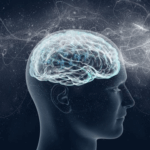Do you ever feel like your emotions overtake you? It’s as if anger, anxiety, panic, fear, sadness, or numbness hijacks your body. When we experience something overwhelming or traumatic — whether it’s a “little t” or “big T” trauma — the brain can stay stuck in survival mode long after the event is over. Let’s explore what happens and how you can feel more in control of your emotions.
THE BRAIN AND EMOTIONAL OVERWHELM
The brain is a complex organ, working in tandem with the nervous system. To better understand how our minds, bodies, and psyches respond to trauma, let’s simplify it using the triune brain model. This model breaks the brain into three parts, each with separate functions and a sense of time:
- Brain stem (Reptilian brain): Controls automatic functions like breathing, heart rate, and survival responses (fight, flight, freeze).
- Limbic system (Mammalian brain): Processes emotions, stores memories, and regulates how the body responds to stress.
- Neocortex (Human brain): Handles reasoning, problem-solving, and conscious thought.
The nervous system — specifically the autonomic nervous system (ANS) — is vital to how we experience and recover from trauma. It has two main branches:
- Sympathetic nervous system (SNS): Activates the body’s fight-or-flight response.
- Parasympathetic nervous system (PNS): Promotes rest, digestion, and healing.

When trauma happens, the SNS floods the body with adrenaline and cortisol, preparing us to fight, flee, or freeze. The amygdala — the brain’s smoke detector — goes into overdrive, storing the trauma’s emotional imprint. Meanwhile, the rational part of the brain (prefrontal cortex) shuts down. This response leaves the nervous system stuck in a state of hypervigilance or shutdown.
TRAUMA AND THE NERVOUS SYSTEM
Even after the event is over, the nervous system may stay stuck in survival mode. Everyday experiences can trigger the amygdala, causing the body to misinterpret safe situations as dangerous. For example, if someone was mugged at night, walking outside later — even on a safe, sunny day — might trigger the same fear response. This happens because the nervous system holds on to the unresolved trauma, repeatedly activating the same stress patterns.
THE BEST PSYCHOTHERAPY FOR TRAUMA AND ANXIETY
Healing from trauma isn’t one-size-fits-all. Different approaches work for different people. Let’s look at a few powerful methods.
- Talk Therapy: Traditional talk therapy can help process trauma by creating meaning around the event. It engages the neocortex — the rational brain — to desensitize the emotional response. However, since trauma often lives in the body and deeper parts of the brain, talking alone may not fully resolve physical and emotional distress.
- EMDR (Eye Movement Desensitization and Reprocessing): EMDR is a structured therapy that helps the brain process stuck memories. It uses bilateral stimulation — often guided eye movements — to engage both sides of the brain. This encourages the emotional memory (right brain) to integrate with the logical side (left brain), reducing the memory’s emotional charge.
- Somatic (Body-Based) Psychotherapy: Somatic psychotherapy focus on the body’s physical responses to trauma. By mindfully tracking sensations — like tightness or shaking — and staying curious about them, the nervous system starts to regulate itself. This supports the brain’s ability to come back online and break free from the trauma cycle.
- Internal Family Systems (IFS): IFS offers a compassionate way to explore the different “parts” of yourself. For example, you may have an anxious part, a self-critical part, or a numb part — each trying to protect you in its own way. IFS helps you access your Self — the calm, compassionate core of who you are — to build relationships with these parts, helping them heal. Over time, this leads to more emotional balance and a sense of inner leadership.
TOOLS TO CALM ANXIETY, MANAGER ANGER, AND RELIEVE DEPRESSION
Here are a few self-regulation techniques you can try at home:
- Gentle rocking: Spend 5 minutes rocking side to side or back and forth. Notice which movement feels more calming.
- 4-5-5 Breathing: Inhale through your nose for 4 counts, hold for 5 counts, and exhale through your mouth for 5 counts. Repeat 4–5 times to help reset your nervous system.
- Listen to calming music: Find songs — with or without words — that bring you comfort or peace.
- Meditate for 5-10 minutes: Even short moments of mindfulness can create more space between you and your emotions.
- Move your body: A quick 12-15 minute workout boosts dopamine and serotonin — natural mood elevators.
LEARN MORE ABOUT SOME OF THE BEST PSYCHOTHERAPIES TO HEAL TRAUMA AND ANXIETY IN TORONTO.
Healing from trauma takes time and the right support. Whether through IFS, EMDR, somatic psychotherapy, you can start to untangle the emotional knots and reconnect with your resilient, grounded Self.
START YOUR HEALING JOURNEY TODAY
Ready to explore what approach might work best for you? I can help guide your healing journey — you don’t have to do it alone. If you’re ready to start working with EMDR therapist specializing in trauma and anxiety in Toronto, CONTACT ME.